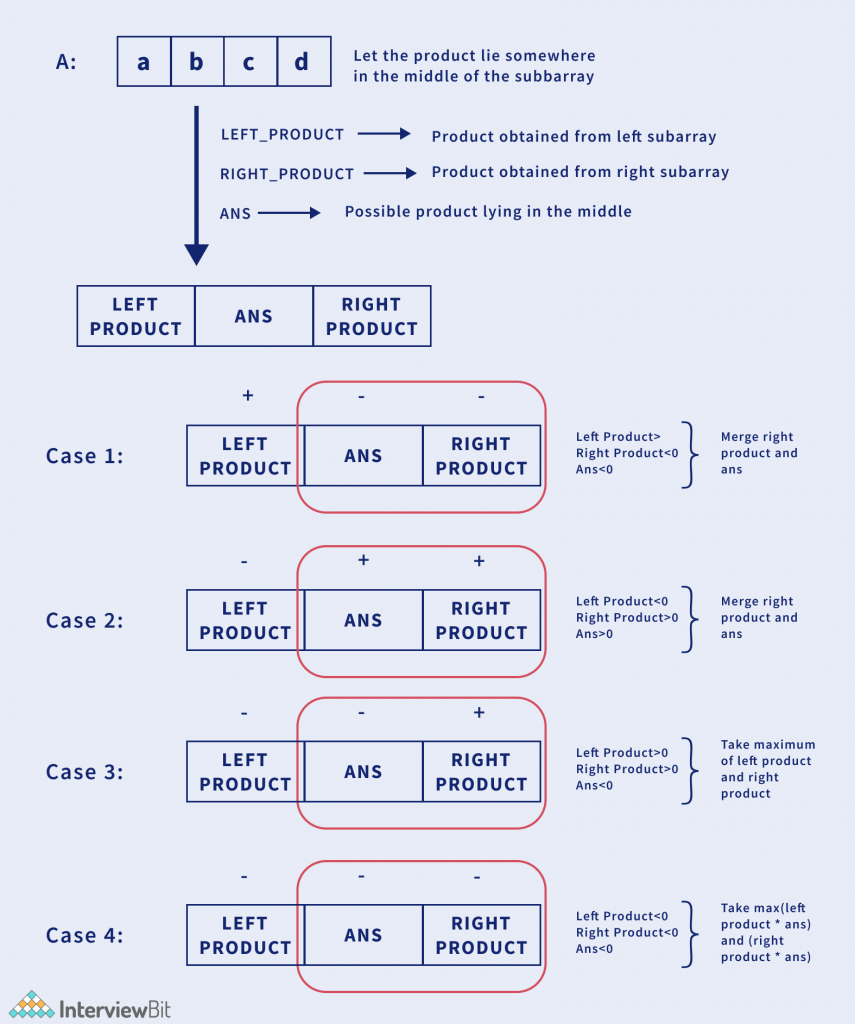Given an array A[] of N positive integers. The task is to find a non empty subarray having the largest product and return the product.
Examples:
Input: A[] = [2, 3, -2, 4]
Output: 6
Explanation: The maximum product subarray is [2, 3] = 6
Confused about your next job?
Input: A[] = [-2, 0, -1]
Output: 0
Approach 1: Brute Force
A simple approach to solve this problem is to find all possible subarrays of the given input array and maximize the product of all subarrays found so far.
Algorithm :
- Initialise a variable result = A[0] to store the maximum product.
- Run two nested loops from i = 0 till N – 1 and j from i + 1 till N and for each subarray A[i….j], find the product of the subarray.
- Update and maximize result.
Implementation of the Approach:
C++ Code
bool isOverlap(int minS, int maxE, vector<int> interval)
{
if (minS > interval[1] || maxE < interval[0])
{
return false;
}
return true;
}
int maxProduct(vector<int> nums) {
if (nums.size() == 0) return 0;
int result = nums[0];
for (int i = 0; i < nums.size(); i++) {
int accu = 1;
for (int j = i; j < nums.size(); j++) {
accu *= nums[j];
result = max(result, accu);
}
}
return result;
}Java Code
public int maxProduct(int[] nums) {
if (nums.length == 0) return 0;
int result = nums[0];
for (int i = 0; i < nums.length; i++) {
int accu = 1;
for (int j = i; j < nums.length; j++) {
accu *= nums[j];
result = Math.max(result, accu);
}
}
return result;
}Python Code
def maxProduct(nums):
if len(nums) == 0:
return 0
result = nums[0]
for i in range(len(nums)):
accu = 1
for j in range(i, len(nums)):
accu *= nums[j]
result = max(result, accu)
return resultTime Complexity: O(N^2), where N is total size of the array
Space Complexity: O(1), as no extra space is used
Approach 2: Dynamic Programming
If we observe clearly, the maximum product will always lie either from the starting of the array or from the end of the array.
To summarise, we have four possible options.
You might think, what if the maximum product lies somewhere in the middle of the array. Let us prove this using contradiction.

In the above example, it has been proved, that the maximum product lies either on the left end or the right end.
Algorithm :
- Initialise a variable result = A[0] to store the maximum product.
- Initialise two variables max_so_far and min_so_far with A[0], which stores the maximum and minimum product obtained so far
- Traverse the input array and for negative element swap max_so_far and min_so_far.
- Maximize max_so_far and update it with max_so_far * A[i]
- Minimise min_so_far and update it with min_so_far * A[i]
- Update result with maximum of max_so_far and min_so_far.
- Return result.
Implementation of the Approach:
C++ Code
vector < vector < int >> merge(vector < vector < int >> & intervals) {
sort(intervals.begin(), intervals.end());
vector < vector < int >> merged;
for (auto interval: intervals) {
if (merged.empty() || merged.back()[1] < interval[0]) {
merged.push_back(interval);
} else {
merged.back()[1] = max(merged.back()[1], interval[1]);
}
}
return merged;
}Java Code
int maxProduct(vector < int > nums) {
if (nums.size() == 0) return 0;
int max_so_far = nums[0];
int min_so_far = nums[0];
int result = max_so_far;
for (int i = 1; i < nums.size(); i++) {
int curr = nums[i];
int temp_max = max(curr, Math.max(max_so_far * curr, min_so_far * curr));
min_so_far = min(curr, Math.min(max_so_far * curr, min_so_far * curr));
max_so_far = temp_max;
result = max(max_so_far, result);
}
return result;
}Python Code
def maxProduct(self, nums: List[int]) -> int:
if len(nums) == 0:
return 0
max_so_far = nums[0]
min_so_far = nums[0]
result = max_so_far
for i in range(1, len(nums)):
curr = nums[i]
temp_max = max(curr, max_so_far * curr, min_so_far * curr)
min_so_far = min(curr, max_so_far * curr, min_so_far * curr)
max_so_far = temp_max
result = max(max_so_far, result)
return resultTime Complexity: O(N), where N is total size of the array
Space Complexity: O(1), as no extra space is used.
Practice Questions:
FAQ
- What if the input array has only positive integers?
If the array contains just positive integers, the maximum product subarray is simply the product of all the integers.
- What is the most efficient approach to solve the maximum product subarray?
The dynamic programming approach is the most efficient approach to solve the problem. The time complexity is O(N) and space complexity is O(1).







 Join WhatsApp Group
Join WhatsApp Group


